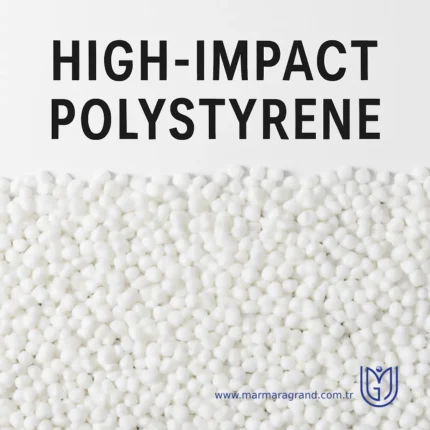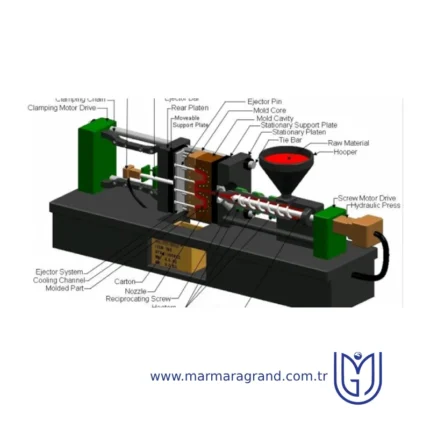High-Impact PolyStyrene (HIPS)
High-impact polystyrene (HIPS) is the rubberreinforced polystyrene plastic which exhibits significantly enhanced impact strength compared to pure polystyrene, while maintaining the main properties of polystyrene such as ductility and reasonable price. It has been widely used in daily equipment. There are two phases in HIPS: polystyrene continuous phase and rubber-dispersed phase. HIPS is usually synthesized by bulk free radical polymerization.
Structure
Structure HIPS consists of long chains of polystyrene in which fine particles of a rubber polymer are distributed. These particles act as a kind of “shock absorber” and prevent cracks from propagating in the polymer.Properties
HIPS has a combination of properties that make it a versatile and widely used material. It is rigid, impact-resistant, lightweight, easy to process, and has a low melting point. HIPS is also resistant to chemicals, oils, and grease. HIPS has a tensile strength of 24.8 MPa (3,600 psi) and tensile modulus of 1.8 GPa (261 ksi) according to ASTM standards, this plastic is capable of withstanding enough force to make it a suitable choice for the packaging industry, and many other products as well.Applications
From the grocery store to the packaging plant to the factory floor, this versatile plastic is a staple across all sorts of sectors. Some examples are:- Knives, forks, and spoons in the food grade industry use HIPS Plastic.
- Elongated profiles found on display stands are created from HIPS Plastic.
- Containers and trays in the packaging industry
- HIPS plastic makes lightweight tubing and profiles common to household goods
- High Impact Polystyrene creates molded parts used to assemble toys
Adavantages
- more environmentally friendly than other plastics
- High Impact Resistance
- Highly Malleable
- Ability to Paint
- Affordable Price
Disadvantages
- HIPS is vulnerable to degradation by many chemicals, including solvents, acids, and alkalis.
- HIPS has a low-temperature resistanceand can become brittle at low temperatures.
- HIPS has limited resistance to UV lightand can become yellow and brittle over time when exposed to UV light.
- HIPS has poor flame resistanceand will ignite and burn easily.
Injection Molding
In injection molding, polymer granules are compressed by a ram or screw, heated until molten and squirted into a cold, split mold under pressure (Figure 26.3(b)). The molded polymer is cooled below TG, the mold opens and the product is ejected. Excess polymer is injected to compensate for contraction in the mold. The molecules are oriented parallel to the flow direction during injection, giving useful strengthening, but properties that are anisotropic. The process gives high-precision moldings, because the polymer cools with the pressure still on but is slow (the cycle time is between 1 and 5 min), and the molds are expensive. Typically, molding temperatures for thermoplastics are between 150 and 350 °C (1.3 and 1.6 TG) and the pressures needed to give good detail are high—typically 30–120 MN m−2.
Types of injection moldingGas-Assisted Injection Molding This process involves injecting gas (commonly nitrogen) into the molten polymer during molding. The gas pushes the molten plastic against the mold walls, creating hollow sections or reducing the amount of material used. Thin-Wall Injection Molding This method Focuses on producing parts with very thin walls, typically less than 1 mm. This requires specialized molds and machines capable of handling high pressures and fast cycle times. Liquid Silicone Rubber (LSR) Injection Molding This method is Used exclusively for liquid silicone rubber (LSR), a thermosetting material that cures when heated. LSR is injected into a heated mold, where it solidifies into a flexible and durable part. Structural Foam Molding A process where a foaming agent or gas is added to the polymer to create parts with a cellular core and solid outer skin. This reduces density and weight while maintaining strength. Metal Injection Molding (MIM) A process that combines metal powders with a polymer binder to create a feedstock. The feedstock is injected into a mold, then the binder is removed, and the part is sintered to achieve a dense metal component.
Advantages of injection molding
- Injection molding is incredibly cost-effective, especially in high-volume applications where thousands to tens of thousands of parts are printed in a workday.
- Injection molding offers many different materials, both general use, and specialty.
- Injection molding provides immense design freedom to product developers and is only held back by mold design, material specifications, and cost.
- Injection-molded parts can be as small as a grain of rice (or smaller) or can be as large as a car dashboard, depending upon the specific type of injection molding being used.
- Injection molding can produce highly complex parts that would otherwise be too time-consuming or difficult to produce with traditional subtractive manufacturing methods.
- Injection molding is a low/no waste manufacturing method, and waste can typically be 100% recycled and reground into stock material for a new injection mold.
Disadvantages of injection molding
- High initial tooling and equipment costs.
- Long lead times for mold design and production.
- Material limitations and risk of defects.
- Environmental and sustainability concerns.
- Design constraints requiring engineering expertise.
- Best suited for high-volume production.
Applications of injection moldingPlastic injection molding is used throughout industry as a means of manufacturing plastic parts in high volumes. Its applications are theoretically endless given the various types of injection molding available combined with its popularity. Still, there are some core usages for which the injection molding process particularly excels. Examples of injection molding applications include (but are not limited to):
- Automotive components
- Food and Beverage packaging
- Stock materials (spools, bar, tube, etc.)
- Toys and figurines
- Furniture components
- Fixtures and fasteners
- Mechanical components (gears, valves, pumps, linkages, etc.)
- Electronic hardware and housings
- Medical device components
- General plastic parts










